Using the Initial Configuration Wizard
A newly created or reset Traffic Manager virtual machine requires some basic information to function normally. The Traffic Manager gathers this information over a series of steps that form the Initial Configuration wizard.
You can access the first page of the wizard by entering the URL of the Admin UI into your Web browser. The first window of the Initial Configuration wizard appears.

•Click Next to begin using the Initial Configuration wizard.
Entering the Administrator Password
To authenticate yourself as the person who launched the instance, enter your administrator password on this page to proceed.
If you provided an SSH key instead of a password when you created the cluster, you must first connect to the instance through SSH and use the z-reset-password command to set an administrator password before you can complete the Initial Configuration wizard.
To enter the administrator password
1.Enter your password.
2.Click Next.
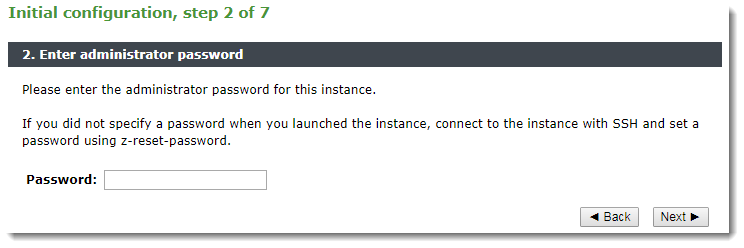
Accepting the License Agreement
This step requires you to read and accept the Ivanti End User License Agreement.
To accept the license agreement
1.Read the entire license agreement located at the URL shown below.
2.Click the I Accept the License Agreement check box.
The Traffic Manager software is usable only after you have accepted the license and completed the wizard.
3.Click Next.

Setting the Date and Time
Set the date and time for your Traffic Manager instance. Setting this correctly ensures that any logs and diagnostic messages generated by the Traffic Manager have the correct timestamps.
To set the date and time
1.Specify the appropriate time zone.
2.Enter the date and time in the fields shown.
3.Click Next.

Setting System Security
The Traffic Manager requires a password for the primary (admin) user. This password overrides the administrator password you specified, if applicable, when you created the virtual machine.
Use the admin password to configure an instance through a Web browser, or when you log in to an instance using SSH (with the username admin).
The Traffic Manager also contains an SSH intrusion prevention tool to help prevent brute-force SSH attacks on your Traffic Manager instance. Ivanti strongly recommends you enable this option.
To enable system security settings
1.Enter the admin user password you want to use.
2.Confirm the password by entering it again.
3.Click Enable SSH Intrusion Prevention if required.
4.Click Next.
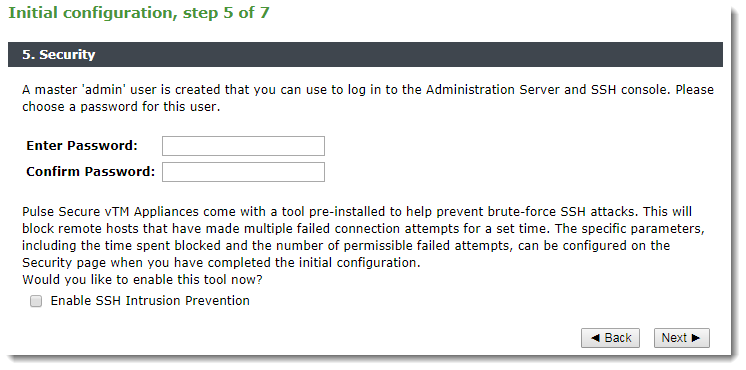
Uploading the License Key
This step applies only to unlicensed Traffic Manager variants and does not appear for set-frequency billing subscriptions where the license is built in.
To upload the license key
1.Click Upload a license key for this traffic manager
2.Click the Choose File button to select the license key to want to upload.
3.Click Next.
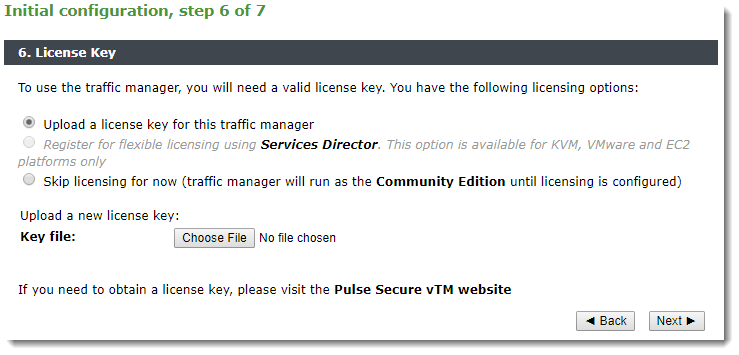
This page includes the option to skip uploading a license key and instead run the Traffic Manager software as the Community Edition. For further information, see The Community Edition.
You can upload a full license key file using the following methods:
•When you first log in to the Admin UI of an unlicensed Traffic Manager instance.
•At any time, through the System > Licenses page.
For information about paid licensing, contact Pulse Secure Technical Support.
Reviewing the Settings Summary
The Summary page displays the settings you configured when you were using the Initial Configuration wizard.
To review the settings summary
1.Review the information displayed.
2.Click Finish or click Back to make changes.
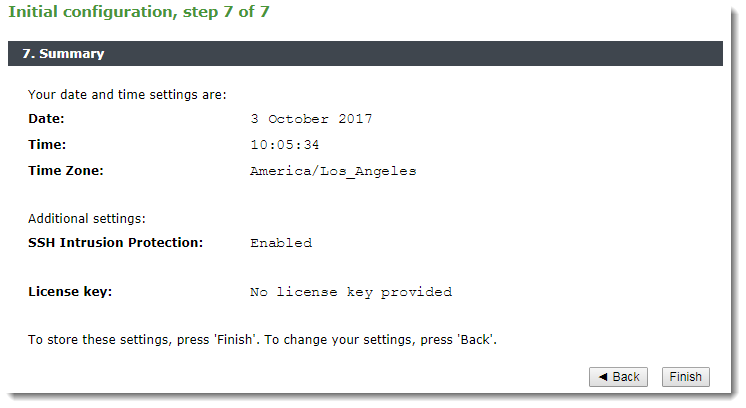
Finishing the Initial Configuration
After clicking Finish at the Summary page, the Initial Configuration, Finished step appears.
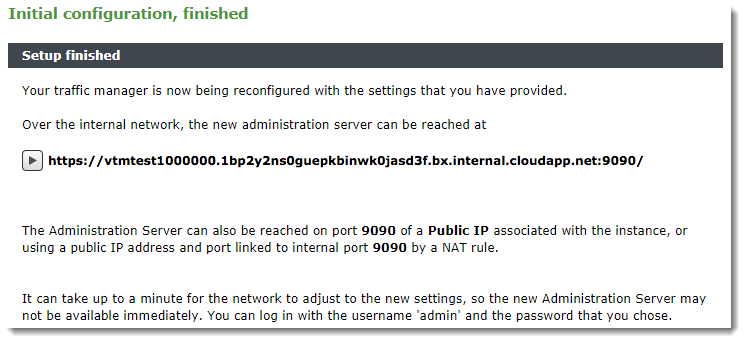
To access the Admin UI of your configured Traffic Manager, use the public IP address or fully qualified DNS name with the dedicated administration port assigned to the instance when you created the cluster. To obtain these details, see Connecting to the Admin UI.
If you are connected to the same internal network as the cluster you created, you can use the URL shown on the “Setup finished” page.
Log in using the username “admin” and the admin password you set when you used the Initial Configuration wizard.